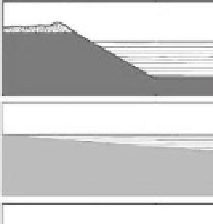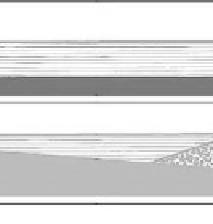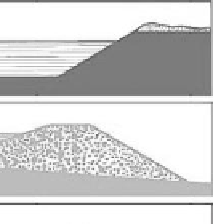Environmental Engineering Reference
In-Depth Information
Excavated
Embankment
Combination
FIGURE 4.14
Major types of pond excavations. (From: http://www.dnr.state.oh.us/wildlife/Home/fishing/
pond/construction/tabid/6218/Default.aspx. With permission.)
implementation in most cases. The cost of excavating and lining a new sur-
face reservoir and the challenge of maintaining sufficient water quality are
the major foreseeable concerns.
The most suitable type of reservoir depends on site characteristics such as
topography, soil composition, and local regulations. The main types of reser-
voir (pond) designs are excavated, embankment, or a combination. Excavated
ponds are more common on flat terrain; embankment ponds are commonly
used with sloping terrain. Figure 4.14 illustrates these pond excavations.
In an aquifer UPHES system, the water level in the pond will rise and fall
frequently. The magnitude of this change will depend on the volume and
surface area of the reservoir with respect to the amount of water pumped
or injected. If the pond water is to be used directly for crop irrigation, the
volume of water must be sufficient to support both irrigation and aquifer
injection volumes. As reservoir surface area increases, however, evaporation
losses also increase. The reservoir volume and depth must be traded with
the allowable water level change. While an aquifer UPHES consumes no net
water during operation, a reservoir owner must have sufficient water rights
to account for any losses due to evaporation or irrigation uses.
Excavation costs can range widely, depending on the soil type, size, and
local labor rates and economics. Finally, a hydraulic interface that allows
water to be pumped in and out of the reservoir is required for an aquifer
UPHES. This will necessitate the installation of underground or above-
ground water piping and valves interfacing the reservoir to the well.
System Efficiency
The efficiency of the operation of an aquifer UPHES system is an important
measure of its feasibility. In this section, estimates of the efficiencies of the
components and the resulting system efficiencies are provided. In previous




